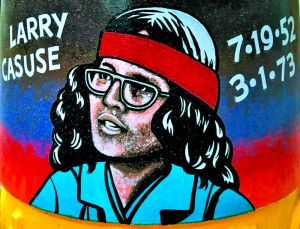Larry Casuse
David Correia begins An Enemy Such as This by detailing the history of scalp hunting that orginiated in Mexico’s genocidal nineteenth-century campaign to exterminate the Apache. The practice became so prevalent that an entire regional economy developed around it. Apache scalps outpaced beaver pelts as the most valuable commodity on the frontier.
Mexican politicians and American and French businessmen subsidized this lucrative enterprise. Often politicians and businessmen were the same people, as the story of Santa Rita mine owner Steven Curcier demonstrates, a story Correia documents to tell the colonial history of Santa Rita copper mine where Larry Casuse’s father, Louis, worked, and where Larry was born. Soldiers, mercenaries, and trappers became entrepreneurs, skilled in the art of the hunt.
Indian killing became a profession.
Fast forward to 1973. Larry is fed up with the politicians and businessmen in Gallup, New Mexico. For the previous decade, Gallup’s local elite owned and operated the Navajo Inn, perhaps the most notorious liquor establishment in Gallup’s history. By the late 1960s, it was the most profitable bar in the state of New Mexico. Located mere yards from the boundary of the Navajo Nation, the bar represented misery and death for Navajo people, who frequently died along Highway 264 from exposure or car-related accidents. By the mid-1970s. McKinley Country—with Gallup as its county seat—had the highest alcohol-related mortality rate in the nation.
As Correia notes, “Larry would have pointed out that Navajo misery in Gallup was not an aberration or product of past colonial conquest. Navajo immiseration produced the conditions that made the Gallup economy possible in the first place.” Once hunted for their scalps, Indians were not hunted according to the cruel calculations of the bordertown’s predatory economy. The trade was still their death, their flesh. The profession had been replenished with a new generation of Indian killers: pawnbrokers, liquor store owners, and traders.
These were the conditions on March 1, 1973, when the foot soldiers—cops—of Gallup’s elite murdered Larry. As Correia writes, Larry’s mother Lillian, who was across the street in Gallup’s welfare office, recalls someone storming into the office yelling, “That Larry Casuse finally got what he deserves.” Reporters from the town’s newspaper took photos of Gallup police posing with Larry’s body – a souvenir from their kill.
Like many Native people before him, Larry had been deemed a threat. Suspicious. Criminal. Hunted and then killed, his love for his people all the more reason to celebrate his death.[1]
Sources
- ↑ An Enemy Such As This: Larry Casuse and the Fight for Native Liberation in One Family on Two Continents over Three Centuries, David Correia, Introduction by Melanie K. Yazzie, Page:x-xi
